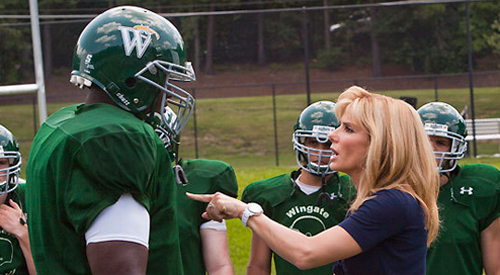
The Blind Side (2009)
Rating: 6/10
The Blind Side is a powerful movie with heartwarming message that led the way to the 2009 Academy Awards, picking up a Best Picture nomination in the process.
Judging by its mass success, the film from director John Lee Hancock can be enjoyed by people of all ages interested in a transformation story. More so by sports fans whove read Michael Lewis original book; The Blind Side: Evolution of a Game.
The Tuohy family are very collected and admired by others. Leigh Anne, played by Sandra Bullock, and Sean, played by Tim McGraw, do their part for the community by donating towards the school their children attend and are kind to the people around them. One cold and rainy night, Leigh Anne is driving along the slippery road only to find an African-American teenager drenched from head to toe; walking along the shoulder. This lonely teen is Michael Oher, yes, he who currently suits up in real life for the Baltimore Ravens.
Leigh Anne calls Michael out of the rain and eventually welcomes the domestically-challenged teen into her home. As time goes on, Michaels bond with the family grows, he becomes a key member of the Tuohy family and well-respected around school, despite existing racial tension in the community. It’s quickly that the high school football coach notices the 64 young man and realizes that he may be a good addition to his team.
[php snippet=1]
The film works as a motivational tool celebrating the rise of a man once lacking the support and resources to achieve his full potential. Even though the message of the story is very uplifting, it’s almost too cartoony at times. Good examples of how this reality ends up twisting surreally is the character of coach Burt Cotton, played by Ray McKinnon.
The movie paints Cotton as a bumbling caricature whose mannerisms are reminiscent to personas Don Knotts might portray. The movie materializes a lot of bit players as two dimensional figures with little motivation. The characters afraid of black people are discomforting due to the fact that they have no apparent motivation to dislike the race. It works in order to get shallow emotional rises out of movie goers but in order for the movie to receive more of an emotional rise, the characters needed to be more developed.
Another problem with how writer/director John Lee Hancock portrays the story’s characters is the fact that the Tuohy’s are illustrated in a blindingly positive light. The Tuohy’s are written as if invulnerable to negativity. Even the main conflict doesn’t feel complicated enough because of how little it would affect Oher and the family. Overall its a gigantic shoulder shrug of a climax.
The script is riddled with plenty of cliches and the way Hancock handles the subject material doesn’t help at all. In a scene where Michael and the youngest Tuohy, S.J, are driving in a car, its prolonged for such an unusual amount of time that the audience knows something bad is right around the corner. Even if Hancock followed the story note-by-note and didn’t miss a beat, he needs to learn how to portray his information so that it doesn’t seem so formulaic and predictable.
With all this aside though, the emotional resonance the message holds is quite affecting and touching. The fact that this happened in real life makes the story that much more outspoken.
Even though the film has plenty of flaws with it’s writing and direction, which ties in with how poor the portrayals are within this film, it still manages to leave an impact. It’s so expressive in transferring it’s moral to an audience, that I have no doubt people would think twice before making snap judgments about the less fortunate. In that sense, The Blind Side is successful.
[php snippet=1]

